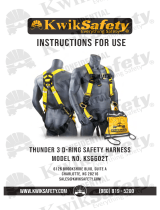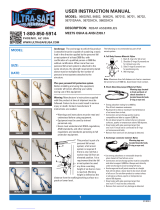
12
1.0 APPLICATIONS
1.1 PURPOSE: Full Body Harnesses are to be used as components in Personal Fall Protection System designed to prevent a
fall or safely arrest a fall (see Figure 2). Full Body Harnesses are used in the following applications:
A
Fall Arrest: Personal fall arrest systems typically include a Full Body Harness and a connecting subsystem (Energy Absorbing Lanyard, Self-Retracting
Device, etc.). Maximum arresting force must not exceed 1,800 lbs (8 kN).
Attachment Elements: Dorsal (feet fi rst with a 2 ft. maximum free fall when using a Self-Retracting Device or 6 ft. maximum free fall when using an
Energy Absorbing Lanyard), Sternal (feet fi rst with a 2 ft. maximum free fall), Frontal (feet fi rst with a 2 ft. maximum free fall).
B
Work Positioning: Work positioning systems typically include a Full Body Harness, positioning lanyard, and a back-up personal fall arrest system. For
work positioning applications, connect the work positioning subsystem (example: lanyard, Y-lanyard, etc.) to the lower (hip level) side or belt mounted
work positioning attachment anchorage elements (D-Rings). Never use these connection points for fall arrest.
Attachment Elements: Frontal, Hip.
C
Climbing: The Full Body Harness is used as a component of a climbing system to prevent the user from falling when climbing a ladder or other climbing
structure. Climbing systems typically include a Full Body Harness, vertical cable or rail attached to the structure, and climbing sleeve. For ladder climbing
applications, harnesses equipped with a frontal D-Ring in the sternal location may be used for fall arrest on fi xed ladder climbing systems.
Attachment Elements: Sternal
D
Rescue: The Full Body Harness is used as a component of a rescue system. Rescue systems are confi gured depending on the type of rescue. For limited
access (confi ned space) applications, harnesses equipped with D-Rings on the shoulders may be used for entry and egress into confi ned spaces where
worker profi le is an issue.
Attachment Elements: Dorsal, Sternal, Frontal, Shoulder
E
Controlled Descent: For controlled descent applications, harnesses equipped with a single sternal level D-Ring, one or two frontal mounted D-Rings, or
a pair of connectors originating below the waist (such as a seat sling) may be used for connection to a descent or evacuation system.
Attachment Elements: Dorsal Sternal, Frontal
F
Restraint: The Full Body Harness is used as a component of a restraint system to prevent the user from reaching a fall hazard. Restraint systems
typically include a Full Body Harness and a lanyard or restraint line.
Attachment Elements: Dorsal, Sternal, Frontal, Hip
Certain application and work conditions require the use of Full Body Harnesses with specifi c attributes:
• Full body harnesses with Kevlar web should be used when working with tools, materials, or environments of high temperature (foundries, chemical
manufacturing, steel fabrication, emergency rescue services, fi re services, welders, oil industry, nuclear industry, explosives).
• Harnesses with PVC coated hardware should be used when working in explosive or electrically conductive environments, or where surfaces must be
protected from the hardware.
• Harnesses with high visibility webbing should be used when increased visibility of the user is required.
1.2 STANDARDS: Harnesses included in this manual conform to the standard(s) identifi ed on the cover of this instruction.
1.3 TRAINING: It is the responsibility of the user and the purchaser of this equipment to assure that they are familiar with
these instructions, trained in the correct care and use of, and are aware of the operating characteristics, application limits,
and the consequences of improper use of this equipment.
1.4 LIMITATIONS: Always consider the following application limitations before using this equipment:
• CAPACITY: The Full Body Harness is designed for use by persons with a combined weight (clothing, tools, etc.)
ranging from 130 lbs (59 kg) to 310 lbs (140 kg)
1
. Make sure all of the components in your system are rated to a
capacity appropriate to your application.
• FREE FALL: Personal fall arrest systems used with this equipment must be rigged to limit the free fall to 6 feet (1.8
m)
2
. Restraint systems must be rigged so that no vertical free fall is possible. Work positioning systems must be
rigged so that free fall is limited to 2 feet (.6 m) or less. Personnel riding systems must be rigged so that no vertical
free fall is possible. Climbing systems must be rigged so that free fall is limited to 18 in. (.46 cm) or less. Rescue
systems must be rigged so that no vertical free fall is possible. See subsystem manufacturer’s instructions for more
information.
• FALL CLEARANCE: Figure 3 illustrates the components of a Fall Arrest. There must be suffi cient Fall Clearance (FC)
to arrest a fall before the user strikes the ground or other obstruction. Clearance is affected by a number of factors
including: (A) Lanyard Length, (B) Lanyard Deceleration Distance or SRL Maximum Arrest Distance, (C) Harness
Stretch and D-Ring/Connector Length and Settling (typically a Safety Factor of 1.5 ft). Refer to the instructions
included with your Lanyard or Self-Retracting Device for specifi cs regarding Fall Clearance calculation.
• SWING FALLS: Swing Falls occur when the anchorage point is not directly above the point where a fall occurs (see Figure
4). The force of striking an object in a swing fall may cause serious injury or death. Minimize swing falls by working as
directly below the anchorage point as possible. Do not permit a swing fall if injury could occur. Swing falls will signifi cantly
increase the clearance required when a Self-Retracting Device or other variable length connecting subsystem is used.
• EXTENDED SUSPENSION: A Full Body Harness is not intended for use in extended suspension applications. If the
user is going to be suspended for an extended length of time it is recommended that some form of seat support be
used. 3M recommends a seat board, suspension work seat, seat sling, or a boatswain chair. Contact 3M for more
information on these items.
• ENVIRONMENTAL HAZARDS: Use of this equipment in areas with environmental hazards may require additional
precautions to prevent injury to the user or damage to the equipment. Hazards may include, but are not limited
to; heat, chemicals, corrosive environments, high voltage power lines, gases, moving machinery, and sharp edges.
Although PVC coated and zinc plated hardware exhibit excellent corrosion resistance in chemical, acidic, alkaline,
and atmospheric conditions, frequent inspections may be required. Consult with 3M if you question the use of this
equipment in hazardous environments.
• HARNESSES FOR HIGH TEMPERATURE ENVIRONMENTS: Harnesses with Kevlar webbing are designed for use in
high temperature environments, with limitations: Kevlar webbing begins to char at 800° to 900° Fahrenheit. Kevlar
webbing can withstand limited contact exposure to temperatures up to 1,000° F. Polyester webbing loses strength
at 300° to 400° F. PVC coating on hardware has a melting point of approximately 350° F. When working with tools,
materials, or in high temperature environments, ensure that associated fall protection equipment can withstand high
temperatures, or provide protection for those items.
1 Capacity: 310 lbs (140 kg) is the maximum capacity allowed by ANSI/ASSE Z359.11. 3M harnesses are factory tested to a maximum capacity of 420 lbs (191 kg).
2 Fall Arrest Free Falls: Free falls greater than 6 ft. (1.8 m) may be permitted when users are secured to the anchorage with a connecting subsystem which limits maxi-
mum arresting force to 1,800 lbs (8 kN) and is authorized for such use (i.e., DBI-SALA Force 2™ Lanyards).





















